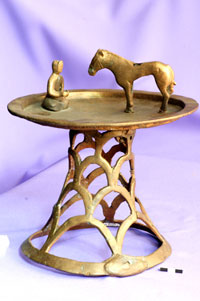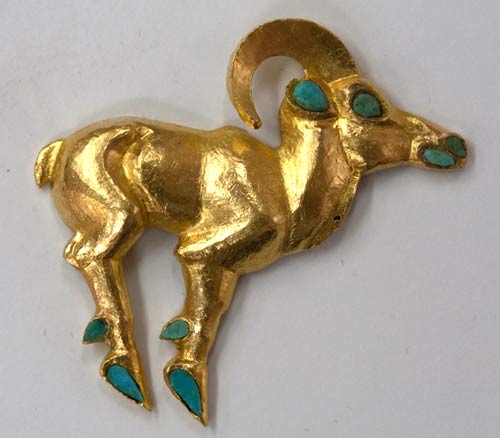
 Sculpture News at SculptSite.com
Sculpture News at SculptSite.com
Musée Guimet Asia in Paris |
 |
Art-of-the-day.infoKAZAKHSTAN: MEN, ANIMALS AND GODS OF THE STEPPEFROM 29 OCTOBER 2010 TO 31 JANUARY 2011Through more than 130 pieces, the first major exhibition on the culture of nomadic horsemen The emblematic venue of Asia in Paris, the Musée Guimet welcomes for the first time in France an introductory exhibition to the history and patrimony of Kazakhstan, a country of the Far-East, of the steppes and nomadic horsemen. This unique event, organized in close collaboration with the officials of Almaty Central Museum and French researchers, and thanks to the patronage of Total, Areva and Astrium, presents pieces that are exclusively from the Kazakh culture, assembled over a century by famous archaeologists, of whom many were Russian and some French, such as François-Joseph Castagné (1875-1958). The heritage of Alexander the Great Located between Russia and China, and inhabited for thousands of years, Kazakhstan finds itself today on a territory that hosted Antique civilizations. The Kazakh people, descendants of Alexander the Great and Genghis Khan, and in spite of the covetousness to dominate the riches and the bitterly disputed territories, were able to maintain their deep character. This people of horsemen is steeped in traditions based on a clan structure and reflects ancient nomadic traditions linked to ethnic, historic, economic and climatic conditions. The Kazakhs have been able to adapt their life style to their traditional practices that characterize a culture, a religion and an art of living. Between archaeology and ethnography The exhibition presented at Musée Guimet brings this country to our encounter through an approach that combines archaeology and ethnography. These two poles illustrate a nomadic truth, at the heart of a dialogue that invites the visitor to explore various itineraries, on the footsteps of these magnificent horsemen from the Asian steppes. As they form one single body with their inseparable companions, the horse, king of the steppes (ridden by certain shepherds), the camel, symbol of every displacement of the camp, and the eagle, the emblem of the country represented under a rising sun, the Kazakhs live in harmony with Nature. They are proud of their mountains and of their animals - from the snow leopard to the falcon, the hunter's helper - and the Kazakhs' attachment to the earth is magnified in an art form that draws its motives from the fauna of the steppes and the mountains, as well as in the attributes of the shaman, or even in the organization of life under the family yurt. Sharing with the spirit of the steppe Built around the rites of nomad people, the exhibition offers a very colorful show as much as an initiatory itinerary. Objects that are witnesses of the wealth of the Kazakh funeral rites dialogue with silver and gold objects on the decorative level, and refer to the landscapes and men who seek to be in communion with the spirit of the steppe to better capture it. The exhibition presents side-by-side archaeological pieces, photographs and objects of every day life - in a very contemporary staging - and helps us understand and share the life of the nomadic horsemen. The itinerary we follow helps us picture a society that evolves in wide, open spaces and groups together in small ephemeral and mobile units. It also presents the continuity between the older Kazakhstan and the contemporary country, placing the Asian steppes at the heart of the Asian question. |
 I find this exhibition of Asia in Paris very interesting. Again it shows what artists created or captured in another time. Sculpture, object art, are all so important to time and culture. I really think it does help to define time and understanding of societal evolution. Time and Sculpture are so linked, intertwined, connected, however you might want to say it. It reminds me of the question: Why do we have time? Answer is quite simple so everything doesn't happen at once |
 Argali, mouflon shaped lamp. Chilikty burial mound Eastern KazakhstanVIIth -VIth centuries B.C. Gold, turquoise.Length 4.1; width 3.9 © Almaty, CSM RK, KP 26860 |
More Sculpture News ....
Submit your SCULPTURE NEWS.
It's easy, just send us an e-mail
(click on Submit News in the left menu) with your pertinent information along with images, we'll take care of the rest. Sculpture makes our world a much better place in so many ways!
SculptSite.com, along with Sculptors and their creative genius all helping to bring the beauty and message of Sculpture to a hurried world.

